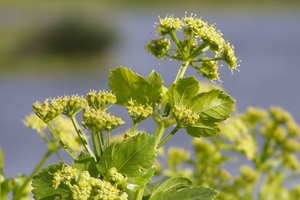Alexanders
 If you visit the coast around Britain during April, even up as far as Aberdeenshire, you are quite likely to stumble across a robust, lime yellow flower dominating the roadsides. This is a biennial plant called Alexanders, which looks for all the world like a small version of Angelica and comes from the same Umbelliferae family. Sometimes it is also known as horse parsley or black lovage.
If you visit the coast around Britain during April, even up as far as Aberdeenshire, you are quite likely to stumble across a robust, lime yellow flower dominating the roadsides. This is a biennial plant called Alexanders, which looks for all the world like a small version of Angelica and comes from the same Umbelliferae family. Sometimes it is also known as horse parsley or black lovage.
Alexanders was yet another species introduced into Britain by the Romans, who called it the “pot herb of Alexandria”, because every part of the plant is edible and they rated it very highly. Originally found around the Mediterranean, it apparently grew in particular abundance around Alexandria, the port town in Egypt.
This might well point to the reason why it tends to be located close to the coastline in this country. Not only is it likely to be slightly warmer next to the sea, but the plant is also tolerant of salt. Having said that, farmers tell me that it is slowly creeping inland, presumably because of the mild winters that we are currently experiencing.
When crushed, both the leaves and stem smell (and taste) of myrrh, and the stems taste very similar to celery, if not a little more pungent. The jet black seeds are peppery and can be added whole or ground into stews and casseroles, giving the dish a wonderful aromatic taste. These seeds contain an essential oil called cuminal, which give off the evocative flavour of cumin and myrrh.
Even the parsnip-like roots of this plant can be boiled and eaten or candied, to be stored over winter. So you can begin to see why the Romans were so keen to bring this plant with them to our shores. Of course, the modern celery plant has now superseded Alexanders, leaving this once highly prized plant, languishing along our coastal lanes – a reminder of days long gone.
Peter Thompson
Advisory
Read more from Peter Thompson at his blog.
Photo credit: Júlio Reis

Download Peter Thompson's essential 26-page book, featuring beautiful photography and detailed profiles of Britain's wildlife
Download FREE >